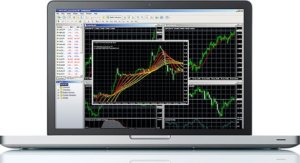14 years of dependability! Where does MetaTrader stand today?
We take a comprehensive look at where the ubiquitous and market-dominating MetaTrader platform stands in today’s ever-evolving FX industry

This editorial was sponsored by EarnForex. All data and research by FinanceFeeds.
Retail FX traders in important regions from mainland Europe to the Asia Pacific region and the MetaTrader 4 platform have been in an almost inseparable alliance for over fourteen years now, indeed ever since the rise to popularity of the now ubiquitous platform, with traders metaphorically joined at the hip to its developer, MetaQuotes, largely due to the reliance on automated trading via Expert Advisors (EAs) which are robots that plug into the platform.
Familiarity breeds contempt, or enables access to a vast client base?
Some say familiarity breeds contempt, others say that he who boldly accepts change when nobody else does is foolish.
The MetaTrader 4 platform embodies both of these contrasting extremities, and is in many respects a legacy platform whose existence for this length of time as a mainstay within the retail sector of a technologically focused electronic capital markets industry is at odds with the leading edge nature of today’s financial technology ecosystem.
In South East Asia and parts of mainland China, the use of trading robots is widespread, and the MetaTrader 4 platform’s compatibility with them has ensured almost unfaltering loyalty among traders and brokerages wishing to provide service to South East Asian clients, even if the platform has had to be modified via the use of third party software from its original format to meet the requirements of today’s modern, direct market access brokerages.
This has led to a function-over-form based universal acceptance of MetaTrader 4 and a need for even large brokerages in Western financial markets centers such as London and New York having had to maintain access by clients to MetaTrader 4 despite having the majority of their client bases firmly ensconced in the use of highly sophisticated in-house platforms which are infinitely superior and engender client loyalty.
Quite simply, as was explained to me last week by a senior executive at one of London’s most established retail FX and CFD firms, the MetaTrader platform is a necessity because it enables large brokers like CMC Markets, IG Group, Saxo Bank and GAIN Capital to on board the entire client base of a smaller broker should an acquisition take place, or should a small broker without its own trading topography go out of business.
Just how many are there?
As a result of its combination of ease of market entry for small to medium sized brokers and widespread familiarity among retail traders in regions which brokerages wish to target, MetaTrader 4 became a household name and although many may debate the reasons behind the success of this platform, placement seems to be the obvious starting point. Quite simply, MetaTrader 4 became the platform of choice.
Despite the tremendous challenges in terms of market saturation, regulatory and advertising-related purges, trade reporting requirements, leverage and execution method restrictions that have become a major expense for many brokers which have far scarcer resources than massively capitalized financial institutions such as mainstream Tier 1 banks, new retail brokers establish different forms of MetaTrader-based businesses almost on a monthly basis.
A healthy combination of white labels, full service brokerages and those providing services as introducing brokers (IBs) make up the industry as a whole.
Recently, FinanceFeeds attempted to decipher exactly how many active MetaTrader 4 trading platforms exist globally by utilizing a custom crawler / spider. We managed to generate a list of active participants using certain relevant keywords to gauge how many results can be retrieved on search engines, our findings being very accurate indeed. We then cross-referenced these results with research that has been conducted from within the industry in order to validate it.
The list that we created was then refined in order to generate a comprehensive list of active websites (live at the time of crawling). This list does not include sites that have yet to be indexed by major search engines or sites that are in foreign languages that do not use English keywords.
The list also does not include brokerages that do not offer MetaTrader 4 such as companies with their own proprietary platforms, for example Dukascopy Bank, Interactive Brokers, and Saxo Bank.
At that time, our research demonstrated that the total number of active MetaTrader 4 brokerages currently stands at 1,231.
Points to note: the list is only comprised of retail FX brokerages which offer the MetaTrader 4 platform. Some of these included may be white labels, full service brokerages or IBs, however; all on the list offer MetaTrader 4 trading in some form or another.
That is significant and demonstrates that whilst many experienced FX industry professionals could certainly consider MetaTrader 4 to be more of an affilite marketing platform than a de-facto trading tool, especially when considering its origins, it is a vital component to over 80% of all brokerages worldwide.
Indeed, if we discount the vast Japanese brokerages of Japan which rely on self-directed traders that do not use MetaTrader at all and manually execute orders and make up 35% of all worldwide retail FX order flow, the number could well be nearer to 95%.
There are upsides and downsides too!
On one hand, MetaQuotes, the platform’s manufacturer, has empowered 1231 retail entities which have not had to invest a single cent into development of their own trading systems, and since 2004 has been the de facto platform for brokers wishing to onboard new customers who are already familiar with a specific system, and also has been the mainstay of vast automated trading entities in the Asia Pacific region whose use of self-developed EAs (trading robots) have been designed around the MetaTrader 4 platform.
On the other hand, it could be argued that those operating with a very much off-the-shelf system may well have gained cheap and easy access to a very lucrative market – a MetaTrader 4 white label license costs just $5000 – but are not masters of their own destiny, something that the removal of the software by its manufacturer is testimony to, and are now in a position where they offer almost identical customer experiences in a market which has ever increasing costs and bureaucratic considerations, hence having to be extremely competitive on just spread and commission in order to get ahead of over 1000 identical competitors is increasingly becoming a squeeze.
In China, for example, which is a nation in which many of the larger MetaTrader 4-orientated brokers derive considerable business, MetaTrader 4 is the platform of choice because of the method by which business is conducted between Introducing Broker networks and retail clients.
Retail clients in China are not traders, they are investors and the Introducing Broker (IB) is often larger than many retail brokerages to which business is referred. In these cases, the IB connects client accounts to a main account and trades them on behalf of the investors, usually via a MetaTrader 4 MAM system controlled automatically by an EA which is often developed by the IB in house.
During the rise of the Chinese IB network, this was a very cheap and easy solution for both IB and broker. Small brokers could establish in Cyprus, obtain a white label license and then generate massive revenues by onboarding IBs in China, who would trade via their EAs.
FinanceFeeds is aware of several cases in which brokerages with absolutely no infrastructure or company structure at all began actively visiting IBs in China and very cheaply generating a vast business solely based on IB revenues with an ‘out of the box’ MetaTrader white label and all of the client bases being hosted on MetaQuotes servers.
What that represents is a sales and CPA business, rather than a structured brokerage.
During this decade-long reign by MetaTrader 4, new platform technology has emerged that connects via API directly to brokerage systems and liquidity feeds, however, such platforms have thus far struggled to topple MetaTrader 4’s gargantuan dominance, until now.
The Far East’s retail electronic trading sector is rapidly evolving, and with Singapore having overtaken Hong Kong as Asia’s number 1 financial center, placing it as the third largest financial center in the world today, the demand for new technology is increasing, emanating from Singapore, which is Asia’s largest interbank and institutional FX center.
For this reason, platform diversity is on the cards in Asia, and going past the traditional idea that EA compatibility trumps all is now a must in order for platform developers to keep a toehold in the most rapidly growing region in the world for the FX industry.
A conclusion here to draw is that brokers which onboard retail clients in their own domestic region, such as IG Group which has 80% of its client base in its home country of Great Britain, would be less reliant on MetaTrader 4, however for brokerages that are established in global financial centers and have reputable regulatory licenses but want to on board large client bases either directly or via partner networks in other regions where the base of traders is more opportunistic and large in number, would be completely reliant on MetaTrader 4.
Take IC Markets as an example. The company has over 20 MetaQuotes server licenses and generates revenues of over $500 million per month, yet is totally reliant on third party technology from MetaQuotes due to the nature and region of its client base.
What’s to like?
MetaTrader 4 has come under tremendous scrutiny by many FX industry commentators (myself included!) and technologists (myself also included!) recently for being a legacy platform which is inflexible in the respect that brokerages cannot own their own intellectual property due to the entire client base being hosted on MetaQuotes infrastructure, its affiliate marketing origins, and its inflexibility in terms of enabling a differentiated client experience to traders or multi-asset product structure without significant intervention from platform integration technology companies.
However, there is far more to the MetaTrader platform than what appears to be an easy way into the brokerage business and transferrability of customers.
Firstly, it is unfalteringly reliable. Considering the proliferation of MetaTrader platforms worldwide, very few technical issues occur on the broker side, server side or client side, and most outages or perceived misdemeanours are often the product of intentionally applied slippage or less reputable unregulated brokerages interfering with trades – something that is very easy to do with MetaTrader’s dealing desk solution.
Behaviour by users, regardless of how dishonourable, however, does not represent technical failing and traders themselves rarely experience anything other than total reliability.
Secondly, it is very simple to use. Brokerages have many core business activities to focus on, one of which is generating and retaining new business, another to ensure trading volumes are consistent and revenue-generating, and of course the risk management of trade order flow being very resource-hungry, therefore training novice traders with relatively low deposits is a difficult endeavor.
MetaTrader 4 is relatively simple and over its long life, it has been a platform that has become easily familiar to all traders at all levels. It is very possible to find a novice trader which only began trading very recently using it freely, just as it is entirely possible to see an experienced algo-trader with decades of experience using it via a direct connection to a liquidity provider or at the desk of a small proprietary trading house.
Functionality is clear, and hedging is easily facilitated, there is a vast support community and market place, and it is easy to switch to a different brokerage should something go awry relationship-wise.
These may seem very gray-suited reasons for adhering to MetaTrader but when considering it as a standard, benchmark platform, these are basic criteria.
Challenges of the future platform tech arena
Last year, in a private symposium organized by Saxo Bank in Hong Kong, a series of proprietary platform developers from Australia and Europe explained to FinanceFeeds that one of the biggest driver of growth over the past twelve to eighteen months has been Prime Brokerage with regard to credit intermediary and clearing.
Overall, with the absolute maturity that the OTC derivatives sector has now achieved, at that meeting in Hong Kong there was very much a focus on the institutional range of services and technology products that major brokerages with their own ability to develop platforms make as proprietary systems for institutional trading and powering brokerage infrastructure.
At the meeting, sophisticated traders using opensource solutions were present, and over 54% of attendees were in Fund and Wealth Management business, whilst only 11% were FX brokers, and 23% FinTech sector.
In terms of what solutions they were looking for, it was deduced that API and Liquidity services customers accounted for 23% of the attendees, whilst Digital Wealth and Robo Advisory stood at 32% and Open API and Platforms amounted to 47%.
There were absolutely no delegates who were under the age of 45, (makes me feel young for once!) and each had a pedigree career spanning at least two decades in institutional wealth management or senior derivatives positions within large institutions.
Similarly, there were no MetaTrader 4 white label owners, and no warehouse dealing desk retail brokers. 85% of attendees at the meeting said that technology has been an enabler of their business and unlike small brokers with warehouse/MetaTrader 4 setups, 59% of today’s delegates explained that they were optimistic about what 2017 holds for their business, difficulties with prime brokerage agreements and regulatory stick-poking not being a concern of theirs at all.
These are very telling figures that demonstrate the demand for high quality institutional-grade proprietary brokerage platforms which allow institutions to code their own front end solution and then tap into brokers, however with the new FinTech age occurring, retail mobile-based platforms are now rife, especially in London which leads the entire challenger bank and new age platform revolution, leading to every type of service from trading to bond investment being now available via apps on smartphones rather than downloadable trading platforms from third party providers.









